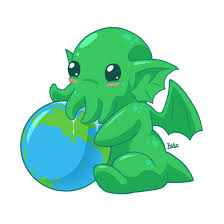

The overall purpose of this project is to analyze a compendium of Lovecraft's peculiar vocabulary that elicit a feeling of confusion, ambiguity, and dread. Our research initially sought out words that are either archaic or obsolete within the modern English vocabulary. That is, do these obsolete words carry any intent to conjure an emotional response to the "eldritch" context of his works. Our research yielded little in this regard, due to the absence of numerous anachronistic words. However, we did notice the intentional usage of scientific, religious, and Gothic terms which evoked what can best be described culturally and emotionally as the "biological sublime"; an overwhelming experience of the uncanny stimulated by Lovecraft's phantasmagorical prose.
We used TEI markup to capture these words. Upon collecting 666 words, we became curious as to the ambiguity of certain terms within our categories of word groups. From here, we used Python and XSLT in order to create a word list of tagged words, their word types, and a representation of ambiguity based on analysis of synsets. Having selected the most intriguing words, we ran them through the search engine of wordnet. This program, stemming from Python, functions as a dictionary/thesaurus tool; in which you can determine a word’s synset count. Synsets are ultimately groups of synonyms, as well as other possible contexts through which words can be employed. This process yielded a decidedly indefinite framework for many of our words. Where we thought certain words carried an obvious connotation, wordnet provided a contrarian result. We then took to arranging the terms in a of hierarchy; categorizing them according to their level of indistinctness.
The Eldritch site features a table where the viewer can search through our sizeable word-hoard and observe the words and measure their ambiguity.Finally, we reincorporated the Python-generated synset and definition information via XSLT into our HTML representation of our chosen set of Lovecraft's texts. We determined that our corpus of texts incorporated more scientific terms than expected. This led to our conclusion that these texts have an inclusive set of words that play to what Lovecraft deemed the "fear of the unknown," through what is threatening to the human-centric world view.
H.P Lovecraft is an early twentieth century writer of "weird fiction." His works are compared to the supernatural heritage of nineteenth century Gothic fiction. The prose of Lovecraft is what distinguishes him from other writers of horror. His verbose style is laden with exotic adjectives and archaic references, which serve to confound the average reader, as Lovecraft wrote pedantically and not to the comprehension level of his readership. His worldview held that humankind is a tragic cosmic accident that is mocked by an ancient race of extraterrestrial gods known as “The Great Old Ones.” Among these beings are: Cthulhu, Nyarlathotep, and Yog-Sothoth.
The tales involving these deities are replete with madness, horror, and bizarre mutations. The Great Old One’s hold humankind with utter indifference, with the exception of the select few who are sensitive to the powers of The Great Old Ones and wish to resurrect them from the darkest regions of the space. This is facilitated by delving into the horrid words of Lovecraft’s forbidden grimoire, "The Necronomicon." The author has crafted many characters who thirst for knowledge and seek to uncover esoteric secrets. These damned figures unleash a bevy of horrors upon an unsuspecting New England. The protagonists of these tales are subjected to atrocities wrought by an unforgiving cosmos and as a result, they go irretrievably insane. We chose our corpus of texts, from the Cthulhu mythos, to reflect these uncanny culture characteristics of Lovecraft's prose.

Matthew Burch is a 2018 graduate of the University of Pittsburgh at Greensburg with a double bachelors’ degree in English Literature and Professional Writing. He also obtained a minor in Theater and the Digital Studies Certificate. Matt’s contribution to the project consisted of text encoding the texts, creating XSLT transformations for the ambiguity table and bar graph, as well as natural language processing using python.

Pat Herron is a 2017 graduate from the University of Pittsburgh at Greensburg with a bachelor’s degree in English Literature. This project started as Pat's brain child with his in depth thesis proposal. Pat participated in the text encoding of the texts and wrote all of the supplementary site documetation.

Evan Tatarka is a 2018 graduate of the University of Pittsburgh at Greensburg with a bachelor’s in Information Technology. Evan wrote the HTML, CSS, and added some complimentary aesthetics (sounds as well as imagery) for the website.
There are many things used within this project that we did not create. These things range from the music used on the several of the page as well as the background images. This is a section of our about page we where will be giving credit to those people.
The music on the homepage comes from the famous Anime Death Note OST, The music was created by composer and musician Hideki Taniuchi and composer Yoshihisa Hirano. We took snippets from the song and edited them in the editing program called Audacity and added it onto the site.The background image used for our homepage was obtained from www.deviantart.com from the user JJcanvas.
The background image used for this about page we got from alpha.wallhaven.cc.
The background image for our "Texts" page is credited within the background and the music on that page comes from two different sources. There is a separate audio clip for the rain noises and one for the creaking ship sounds. The rain noise comes from a video on YouTube that clipped out the rain from the "Halo Reach Theater Lobby". Credit goes to the composers of that music and "Bungie". The composers are Martin O'Donnell and Michael Salvatori. The creaking ship sound is a royalty free sound track from the YouTube channel "n Beats Sound Effects".